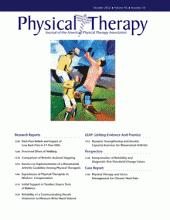Abstract
Background Disability in adults with low back pain (LBP) is associated with negative back pain beliefs (BPBs). Adult BPBs can be positively influenced with education, resulting in reduced LBP disability. By late adolescence, the prevalence of LBP reaches adult levels. The relationship among LBP experience, LBP impact, and BPBs has not been investigated in late adolescence.
Objective The aim of this study was to document unknown relationships among LBP experience, LBP impact, and BPBs in 17-year-olds.
Design A cross-sectional study design was used.
Methods Adolescents (n=1,126) in the Raine Study provided full information on LBP, LBP impact (sought professional advice or treatment, taken medication, missed school or work, interfered with normal activities, interfered with physical activities), BPBs, and a number of covariates.
Results Back pain beliefs were more positive in participants with experience of LBP (X̄=30.2, SD=5.6) than in those without experience of LBP (X̄=28.5, SD=5.1). Individuals with LBP without activity modification impacts had more positive BPBs than those with activity modification impacts, even after adjustment for mental well-being and sex. The adjusted difference in BPBs between participants with experience of LBP but no activity modification impacts and those reporting all 3 activity modification impacts was 2.9 points (95% confidence interval=1.7 to 4.2). Participants with no activity modification impacts had more positive BPBs than those with no experience of LBP (adjusted difference=2.2 points, 95% confidence interval=1.4 to 2.9). More positive BPBs also were associated with female sex, lower body mass index, higher family income, better 36-Item Short-Form Health Survey (SF-36) Mental Health scale scores, and more positive primary caregiver beliefs.
Limitations Cause and effect cannot be ascertained with the cross-sectional design.
Conclusion Differences in BPBs are associated with different levels of LBP impact at 17 years of age. This finding provides a potential target for intervention early during the life course.
Footnotes
Dr Smith, Prof O'Sullivan, and Prof Straker provided concept/idea/research design. All authors provided writing. Dr Smith, Dr Beales, and Prof Straker provided data analysis. The authors acknowledge the Raine Study Team and the Raine Study participants and their families.
Funding was received from the Australian National Health and Medical Research Council (including project 323200, fellowships 425513 and 373638, and program 003209). Funding also was received from the Raine Medical Research Foundation; the University of Western Australia; Curtin University; the Faculty of Medicine, Dentistry and Health Sciences at the University of Western Australia; the Women and Infants Research Foundation; and the Telethon Institute for Child Health Research.
- Received November 11, 2011.
- Accepted June 20, 2012.












